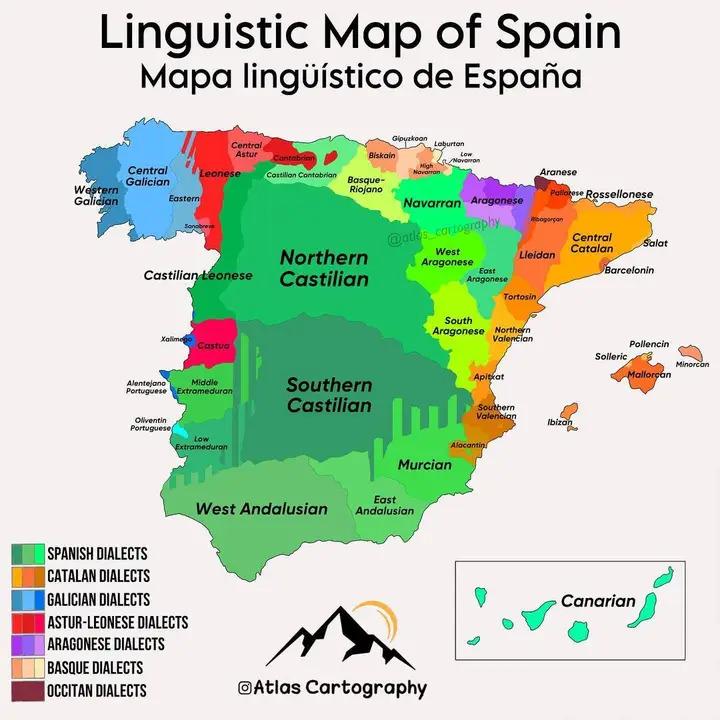

David Chen
Data Visualization Specialist
David Chen is an expert in transforming complex geographic datasets into compelling visual narratives. He combines his background in computer science ...
Geographic Analysis
What This Map Shows
The Linguistic Map of Spain provides a detailed representation of the rich tapestry of languages and dialects spoken across the country. While most people may associate Spain predominantly with the Castilian dialect of Spanish, this map reveals a much broader linguistic landscape. It showcases the distribution and prevalence of several regional languages and dialect groups, including Catalan, Galician, Basque, and others. This map serves as a key to understanding the profound cultural diversity that characterizes Spain, illustrating not only where these languages are spoken but also hinting at the historical and social influences that have shaped their development.
Deep Dive into Linguistic Diversity in Spain
Spain's linguistic diversity is one of its most fascinating aspects, reflecting a complex history of invasions, cultural exchanges, and regional identities. The country recognizes several co-official languages alongside Castilian, which is the dominant language spoken by about 75% of the population. These regional languages are not merely remnants of the past; they are vibrant, living languages that play a crucial role in the everyday lives of millions of Spaniards.
Castilian Dialects
Castilian, or Spanish, has various dialects across the north and south of Spain. In the north, you might encounter a softer accent with different intonations, while the southern dialects, particularly in Andalusia, have distinct phonetic characteristics. Interestingly, the differences can be subtle yet significant, leading to variations in vocabulary and pronunciation. Despite these differences, speakers of various Castilian dialects generally have no trouble understanding each other, a testament to a shared linguistic heritage.
Catalan Language and Its Dialects
Catalan is spoken primarily in Catalonia, Valencia, and the Balearic Islands, with notable dialects like Valencian and Balearic. Its recognition as a co-official language underscores its importance in regional identity. Catalan boasts a rich literary tradition, and what's fascinating is that it is also spoken in parts of France and Italy, showcasing its influence beyond Spain's borders. The language's revival in recent decades has fueled a strong sense of regional pride, especially amid political movements advocating for greater autonomy.
Galician and Its Unique Identity
Moving to the northwest, Galician is spoken predominantly in Galicia. It's a language that shares roots with Portuguese, reflecting the area's historical ties to the region across the border. With over two million speakers, Galician is integral to the cultural identity of Galicia. The language is celebrated in local literature, music, and festivals, highlighting its ongoing relevance and vitality in modern Spanish society.
Basque: A Language Isolate
Basque (Euskara) is truly unique, as it is a language isolate with no known relatives in the world. Spoken in the Basque Country and parts of Navarre, its origins remain a mystery, which adds to its allure. The Basque language has seen a resurgence in recent years, particularly in education and media, reflecting a renewed sense of pride in Basque culture. Interestingly, the Basque Country has a distinct identity that is separate from Spain, and the language plays a central role in that identity.
Other Regional Languages
Additionally, Spain is home to other regional languages and dialects, such as Aragonese, Astur-Leonese, and Occitan (Aranese) in the Val d’Aran. These languages, while less spoken, contribute to the country's linguistic mosaic and reflect the diverse history of the Iberian Peninsula. The existence of these languages illustrates the importance of preserving regional identities and cultures in a globalized world.
Regional Analysis
The linguistic landscape of Spain is not uniform; it varies considerably by region. For example, in Catalonia, the push for Catalan has led to significant government support for its use in education and public life, while in Galicia, the revitalization of Galician has garnered similar enthusiasm, albeit with varying degrees of success.
In contrast, languages like Aragonese and Astur-Leonese face challenges regarding their survival, as younger generations are increasingly opting for Spanish over their ancestral tongues. The linguistic map highlights these disparities, showing areas where regional languages thrive alongside Spanish and others where they are at risk of disappearing. The coexistence of these languages often leads to rich cultural exchanges, but it also raises questions about language preservation and identity.
Significance and Impact
Understanding the linguistic diversity of Spain is essential for grasping the complexities of its cultural identity. Language is a powerful tool for expressing regional pride and heritage, and it often plays a crucial role in political movements. For instance, the push for Catalonia's independence has been intricately tied to the promotion of the Catalan language, as it symbolizes a commitment to regional autonomy.
Moreover, as globalization continues to influence societies, the future of these regional languages hangs in the balance. Current trends show a growing interest in bilingual education and cultural heritage initiatives, which may help revive and sustain these languages for future generations. As we look ahead, the linguistic map of Spain serves as a reminder of the importance of preserving linguistic diversity as a vital aspect of the country's cultural fabric.
In conclusion, the Linguistic Map of Spain not only illustrates where these languages are spoken but also opens a window into the rich cultural identities that define the Spanish nation. As we navigate an increasingly interconnected world, recognizing and valuing this diversity becomes ever more crucial.
Visualization Details
- Published
- October 21, 2025
- Views
- 28
Comments
Loading comments...